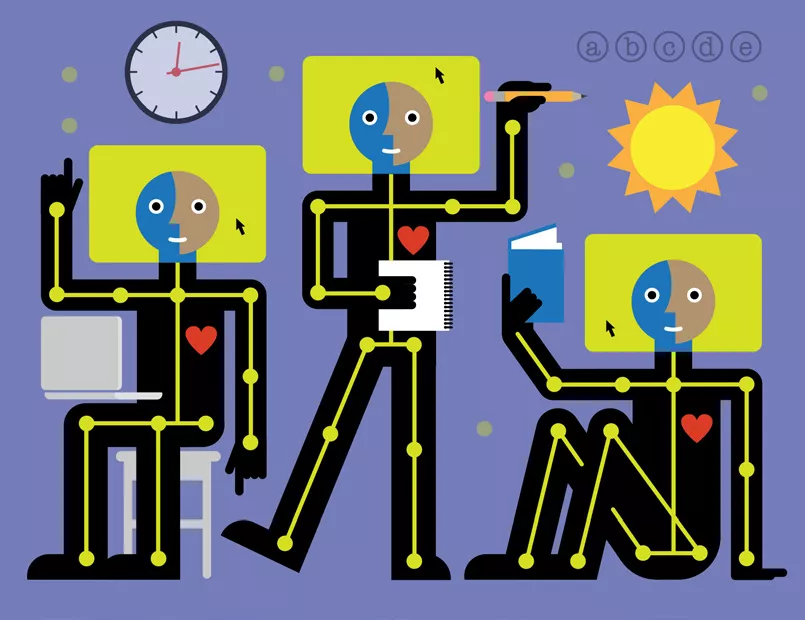
Thriving in Academe is a joint project of NEA and the Professional and Organizational Development Network in Higher Education (www.podnetwork.org). For more information, contact the editor, Molly Mann ([email protected]) at St. Francis College or Mary Ellen Flannery ([email protected]) at NEA.
In academe, our collective misunderstanding of thinking as a head-only process has impaired our understanding of learning and practices of education. Our unfortunate but common practice of treating learners like “brains on sticks” (a metaphor reputedly made first by eco-philosopher Joanna Macy) resonates because we’ve created and reinforced a divide between brain and body in Western culture for hundreds of years.
Today, the field of embodied cognition tells us the body plays a vital role in cognition. Indeed, dealing with the physical—even in virtual, online learning spaces—can offer new and unusual ways for educators and learners to connect with each other and take risks together as human beings.
Embodied cognition draws from brain science and phenomenology to explore how bodies shape perception. A general explanation begins with the position that our brains are not autonomously in charge, issuing orders to various body parts. Rather, the brain acts as a site for hosting and curating conversations; organs in this dynamic system, like the heart and lungs, communicate through a variety of channels, including electrical, hormonal, and mechanical. Signals are sent through nerve endings in our skin, through internal organs and tissues, and through hormonal balances and the state of our immune system, each of which interact with prior knowledge and experience to produce perception (see Barrett 2020).
Embodied cognition explains why cognitive function depends so much on bodily well-being and, in turn, bodily well-being on a supportive environment. Emotional stress and lack of sleep, movement, fresh air, and nutritious food are often at the root of poor or inconsistent intellectual functioning. How often has a familiar task, like answering email, taken longer and seemed more difficult when we are tired or distracted by worry? Behavioral scientists Sendhil Mullainathan and Eldar Shafir (2013) refer to this phenomenon as a taxed bandwidth that affects not only our memory function but our brains’ executive control: we can give the impression of being “not all there,” or having poor judgment or self-control, because our bodies are struggling to provide the necessary energy to think. To learn well, we must preserve or recover cognitive bandwidth.
I recommend four strategies, useful in both asynchronous and synchronous virtual modes, to provide students with the best conditions for cognitive performance:
Strategy #1: Recognize the impact of physical spaces on learning.
What do you know about the physical learning environments of your students? Are they working at a table in a dedicated area of their homes, or from a smartphone on the sofa or bed? Do they listen to or watch recorded content while commuting to work? Environmental affects cognitive performance, and students should be offered opportunities to be intentional about choosing, designing, or improving a learning space. Ideally, a learning space would help reduce the mental requirements of a task—a concept called cognitive offloading—through easy access to physical tools like pens/pencils and paper, a whiteboard, or reference sources. There should be a degree of ambient noise or silence intentionally selected. At the beginning of your course, ask students to post photos of the spaces where they’ll be learning, and to share ideas for “third place” (neither home nor school, but libraries, coffee shops, park) they might be able to use for variety.
Strategy #2: Send learners outside.
An ideal cognitive space enables stretching and moving around, which aids in creative thinking and idea-generation. Alertness is enhanced by fresh air and natural light.
Since learners benefit from changing up the spaces where they work, strategy #2 encourages them to literally think outside the box. Look for ways to assign audio content that they can absorb while walking, doing outdoor chores, using public transportation, cycling, etc. Create a personalized field trip assignment that allows them to visit a relevant local site on their own or gather perspectives from other people and report back with photos, videos, or audio recordings. Online education has the potential to largely free us from “seat time” by using technology more intentionally (see Bruff, 2019). We should make use of this freedom by sending students out into the world for learning experiences, and by gathering synchronously for experiences that are important to share.
Strategy #3: Build movement into classroom time to create community and a sense of belonging.
Whether your course is built on a sequence of synchronous class meetings, or you meet only occasionally online, consider ways to acknowledge everyone’s embodied presence in the virtual space. Shared physical activity might involve gentle breathing routines to bring ourselves fully present into the moment, or “chair yoga” stretches to offer a cognitive reset after long periods of focused listening and discussing. Check out free YouTube videos and narrated audio practices (such as those available through the Greater Good in Action website) that can enable you to click play and participate along with students as a boost for yourself. A quick search for “creative icebreakers for virtual meetings” will yield other ideas for physical activities; theater improv and dance instructors have developed warm-up rituals that use rhythm and gestures effectively online.
Strategy #4: Use multi-sensory activities to build social relationships among students.
A sense of belonging offers students the chance to recover needed bandwidth for learning. Social annotation tools (e.g. VoiceThread, Perusall, or Hypothes.is) enable students to post written responses to course-related images and audio/video files; students also can record their own voices and images when responding via discussion board. A live virtual class might involve exploring discrete physical objects together, or a bring-your-favorite-snack night. The pleasures of learning can be amplified through social connection, even when that involves simply being present for an experience together.
Coexperience, such as watching a film or exploring unfamiliar objects at the same time, involves “simply experiencing something in parallel with a close other—without communication or any explicit interaction” (Boothby et al 2017, 694).
When coexperiencers feel safe together they spend less energy monitoring their social situation and pay closer attention to the environment. Witnessing stimuli in the company of trusted others can make objects seem more appealing and even more real. The phenomenon of coexperience suggests that learning with others whom we trust improves the depth of our cognitive processing. In collaborative work, students who have built familiar, comfortable, and trustworthy relationships can encourage each other to persist in challenging moments.
Unlike the dynamic experience of learning through movement and sensations, learning in the industrial age has focused on statis: we sit, listen, and perform a kind of absorption that we imagine takes place entirely within the confines of our skulls. That stasis has informed our sense of educational norms, and the infrastructure of remote learning reflects it. While technology makes education accessible for many, it may also exacerbate sedentary habits that are detrimental to human health and well-being.
Students aren’t brains on sticks, and if we ignore the vital role of the body in cognitive perception, we miss out on enormous potential for deeper learning.

